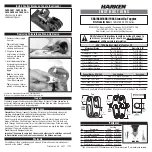
5
12
1.
Before assembling the weight bench, make sure
that you have read and understand the informa-
tion in the box above.
Press a 1 1/2Ó Square Inner Cap (4) into each end of
the Base (3).
Insert the 5/16Ó x 2 1/4Ó Screws (36) up through the
indicated holes in the Base (3). Finger tighten the
Screws into the ÒUÓ-Brackets (2) as shown.
Do not
tighten the Screws yet. Make sure that the ÒUÓ-
Brackets are turned as shown.
1
Before beginning assembly, read the following
information and instructions carefully:
¥
Assembly requires two people.
¥
Place all parts in a cleared area and remove the
packing materials. Do not dispose of the packing
materials until assembly is completed.
¥
Tighten all parts as you assemble them, unless
instructed to do otherwise.
¥
For help identifying small parts, use the PART
IDENTIFICATION CHART on page 4.
¥
As you assemble the weight bench, make sure
that all parts are oriented as shown.
The following tools (not included) may be
required for assembly:
¥ Two (2) adjustable spanners
¥ One (1) rubber mallet
¥ One (1) standard screwdriver
¥ One (1) phillips screwdriver
¥ Lubricant, such as grease or petroleum jelly
plus soapy water.
Assembly will be more convenient if you have a
socket set, a set of open-end or closed-end
wrenches, or a set of ratchet wrenches.
Assembly
Make Things Easier for Yourself!
Everything in this manual is designed to ensure
that the can be assembled successfully by any-
one. However, it is important to recognize that
the weight bench has many parts and and that
the assembly process will take time. Most peo-
ple find that by setting aside plenty of time,
assembly will go smoothly.
2
3
4
4
36
2
36
2.
Slide the ÒHÓ-Frame (5) over the two ÒUÓ-Brackets (2).
Make sure that the ÒHÓ-Frame is turned as shown.
Insert 5/16Ó x 2Ó Bolts (6) through the indicated holes
in the ÒHÓ-Frame (5) and the ÒUÓ-Brackets (2). Tighten
a 5/16Ó Nylon Locknut (7) onto each Bolt.
Fully tighten the 5/16Ó x 2 1/4Ó Screws (36) used
in step 1.
2
Bracket
3
5
7
2
7
2
6
6
Rest for a short period of time after each set. The
ideal resting periods are:
¥ Rest for three minutes after each set for a muscle
building workout
¥ Rest for one minute after each set for a toning work-
out
¥ Rest for 30 seconds after each set for a weight loss
workout
Plan to spend the first couple of weeks familiarizing
yourself with the equipment and learning the proper
form for each exercise.
COOLING DOWN
End each workout with 5 to 10 minutes of stretching.
Include stretches for both your arms and legs. Move
slowly as you stretch and do not bounce. Ease into
each stretch gradually and go only as far as you can
without strain. Stretching at the end of each workout
is very effective for increasing flexibility.
STAYING MOTIVATED
For motivation, keep a record of each workout. The
chart on the following page can be photocopied and
used to schedule and record your workouts. List the
date, the exercises performed, the weight plus the
numbers of sets and repetitions completed. Record
your weight and key body measurements at the end
of every month.
Remember, the key to achieving the greatest results
is to make exercise a regular and enjoyable part of
your everyday life.
MUSCLE CHART
A. Sternomastoid (neck)
B. Pectoralis Major (chest)
C. Biceps (front of arm)
D. Obliques (waist)
E. Brachioradials (forearm)
F. Hip Flexors (upper thigh)
G. Abductor (outer thigh)
H. Quadriceps (front of thigh)
I.
Sartorius (front of thigh)
J. Tibialis Anterior (front of calf)
K. Soleus (front of calf)
L. Rectus Abdominus (stomach)
M. Adductor (inner thigh)
N. Trapezius (upper back)
O. Rhomboideus (upper back)
P. Deltoid (shoulder)
Q. Triceps (back of arm)
R. Latissimus Dorsi (mid back)
S. Spinae Erectors (lower back)
T. Gluteus Medius (hip)
U. Gluteus Maximus (buttocks)
V. Hamstring (back of leg)
W. Gastrocnemius (back of calf)
N
O
P
Q
R
S
T
U
W
V
M
L
J
G
F
H
I
K
E
C
D
B
A


























